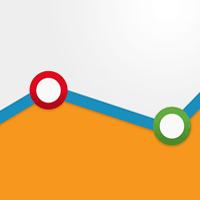High Performance Analytics

 You can't manage what you can't measure and you certainly can't monetize it either. Analytics is the single greatest opportunity you have as an Internet professional to determine how your website is performing. But analytics also indicate how much more you can get out of your investment in your website, both in terms of financials and time commitments. This is high performance analytics.
You can't manage what you can't measure and you certainly can't monetize it either. Analytics is the single greatest opportunity you have as an Internet professional to determine how your website is performing. But analytics also indicate how much more you can get out of your investment in your website, both in terms of financials and time commitments. This is high performance analytics.
Performance analysis involves gathering formal and informal data to help not just ourselves, but also our customers and sponsors define and achieve their goals. Several perspectives on a problem or opportunity, determining any and all drivers toward, or barriers to successful performance, and can help propose a solution system based on what is discovered. Consider performance analysis the front end of the front end - it's what we do to figure out what to do. You can call it planning, scoping, auditing, or diagnostics, but you'll need to roll up your sleeves, prepare yourself to be shocked, and immerse yourself in a lot of creative thinking if you want to move the needle in a positive direction.
Web Analytics: Key Performance Indicators
It might be the least sexy of all Web responsibilities, but analytics is arguably the most important to an online business' success. Unfortunately, it is an area where most enterprises fail to focus their attention.
 Website analytics refers to the measurement that occurs once a visitor arrives on your website and even how they arrived and what they did during a visit - ideally a conversion. The entire undertaking of website analytics is inextricably tied to performance indicators (or key performance indicators - KPIs) that help define and evaluate the success or failure of a particular marketing (SMO or SEO) or advertising (PPC) campaign.
Website analytics refers to the measurement that occurs once a visitor arrives on your website and even how they arrived and what they did during a visit - ideally a conversion. The entire undertaking of website analytics is inextricably tied to performance indicators (or key performance indicators - KPIs) that help define and evaluate the success or failure of a particular marketing (SMO or SEO) or advertising (PPC) campaign.
More often than not, many are content with seeing the most basic charts (unique visitors or page views) move up or down and base important decisions on those simple metrics alone. However, there are an endless number of factors and elements that can and should be measured instead. Identifying what is really important to the stakeholders of your enterprise is what will define your level of engagement with your analytics solution.
Perhaps the most difficult part of Web analytics as it stands today is determining which KPIs to use. The sheer volume of available KPIs can be overwhelming, as can the multitude of ways to compare the data they present and how they align with the objectives of different departments within a company. To help cut through all the KPI confusion and clutter, we've come up with a list of a few basic KPIs that will give the most insight, while requiring the least amount of time and specialty knowledge.
Visitors per Conversion, Lead or Order
How many visitors does it take to achieve your website goals? Whether the objective of your site is to generate leads for the sales team or to have visitors purchase goods or services, this measurement indicates if your website and its promotional channels are working together. Consider this example: You decide to offer a whitepaper because you have exclusive content that will appeal to your target audience. You receive 100 visits to your whitepaper download page, but only 5 people complete the download (convert). This is a good indication that there is a problem with the landing page. Most likely, the layout design is poor, the copy itself is confusing, or the page requires visitors to provide too much personal information. Knowing this, you can tweak these aspects of the page, examine the KPI, and determine what was preventing downloads so that you avoid those mistakes in the future.
Many analytics solutions offer heatmaps to help identify where users are clicking on certain page sections but new tools, including SiteTuners' AttentionWizard.com (in beta) use advanced artificial intelligence algorithms to simulate human visual processing and attention, creating an "attention heatmap" of your Web page. This can predict where people will look during the all-important first few seconds of their visit.
Cost per Lead
For any organization interested in streamlining processes to get the maximum amount of value out of their promotional investments, the cost per lead measurement helps show what techniques or channels are paying off and those that might need to be eliminated. Returning to the whitepaper download example, let's say the aggregate cost of your project (including research, copywriting, design, etc.) was $1,000. If you generated two leads, you would be paying $500 per lead. Since that would be completely unacceptable, it is our responsibility as someone keen on high performance analytics to find ways to cut costs or make modifications to improve response rates and, ultimately, the number of conversions, driving our cost per lead down.
Stickiness
Reviewing the number of page views per visit enables us to measures how deeply a viewer delves into the website content. That is important information, but measuring the level of involvement and length of time a visitor spends within a specific content area will show areas of potential improvement. If viewers are highly engaged in a specific content area, you may decide to keep the section the same, or put links to other parts of your site that relate to that content. If visitors are not spending as much time in a section as they once did, it's probably time to update that content. In some cases, if visitors are not going to a page at all, it can signal a problem with your navigation or promotional channels - perhaps the user did not find what they expected after clicking on a confusing ad, for example. Most Web professionals are concerned only with the activity that occurs on their own websites and for good reason - since we can manage that portion of our business we are better able to actively monetize it. But performance analytics can go much further beyond the posts and pages that comprise our Web properties. By taking full advantage of available analytics, we can discover areas across the Web where consumers are interacting with our businesses, and improve our presence across any number of channels.
 Website Load Time Matters
Website Load Time Matters
It should come as no surprise that fast-loading sites increase user satisfaction but a great many online destinations still suffer from poor performance. Google Site Performance, an experimental Webmaster Tools Labs feature, was released in early December and informs webmasters of their website load time.
Site Performance displays load times of pages along with suggestions on how to improve performance including recommendations such as combining external JavaScript or minimizing DNS lookups. Google also recommends using Page Speed, an open-source Firefox/Firebug add-on that can be used to evaluate the performance of Web pages. Where else can you look to check your website's loading time? Here are two of the most popular resources available:
Pingdom Page Load Test Tool: Tests all objects including images, CSS, flash files, JavaScript, and Framers. Each test shows statistics about total number of objects, total load time and size of all objects.
Internet Supervision: Page load times are affected greatly by geography of the user. This tool enables webmasters to check latency from nine different servers across the globe - including Sydney, Beijing, Chicago, Santiago, Gloucester, Los Angeles, Dortmund and Washington DC.
Video Analytics: Caught on Film
Video continues to spread across the Web, making it an important consideration in online marketing programs.
 Comscore reported that nearly 28 billion videos were watched during November 2009, although the number of unique visitors dipped slightly to 167 million in October from 168 million in September. While video giants like Hulu.com are experiencing phenomenal rates of use by consumers, plenty of opportunities exist for content marketers looking to make their mark with online video. With each and every marketing opportunity, however, comes a responsibility to measure performance and improve upon prior activity. Fortunately, there are video analytics solutions on the market that make the process a breeze.
Comscore reported that nearly 28 billion videos were watched during November 2009, although the number of unique visitors dipped slightly to 167 million in October from 168 million in September. While video giants like Hulu.com are experiencing phenomenal rates of use by consumers, plenty of opportunities exist for content marketers looking to make their mark with online video. With each and every marketing opportunity, however, comes a responsibility to measure performance and improve upon prior activity. Fortunately, there are video analytics solutions on the market that make the process a breeze.
YouTube released its video analytics tool (YouTube Insight) back in March 2008, enabling all users to view statistics about the videos they upload to the site. Video content marketers can see not only how often videos are viewed in different geographic regions and how popular they are during a given period of time, but can even dig deeper into the lifecycle of videos. For example, YouTube Insight provides the ability to see how long it takes for a video to become popular and what happens to video views once their popularity peaks. While this might not seem like much of a value-add, knowing the day a video reaches this tipping point and/or within what region might provide some informed guidance on production schedules and even geo-targeted advertising in the future.
YouTube took its Insight tool in a completely different direction in July 2009, giving users the ability to make the analytical information publicly available to anyone watching videos on YouTube.com. Now, when users watch a video they are presented with metrics - views over time, its popularity in different parts of the world, the top drivers of traffic and the video's top three audience demographics, under the "Statistics & Data" section. Content producers have the option to make this information public by adjusting their privacy settings. By providing this information you might be able to drive additional views and sustain a more engaged audience. For example, if a viewer sees that the video is popular among those in his or her region or age group, the user might be more inclined to recommend that video to a friend, or simply watch the entire video.
Where YouTube provides a starting point for those new to producing and marketing video content, there remains a host of other outlets - making analyzing the performance of this distributed environment much more challenging. However, companies like LiveStream (formerly Tube- Mogul) have all but solved the problem. The company's free inPlay analytics technology now tracks 15 different video sites; including Brightcove, DailyMotion, MetaCafe, blip.tv, Break.com, Howcast, eBaum's World, Graspr, GrindTV, Sclipo, Webcastr, Viddler, 5min, Streetfire.net and Sevenload. LiveStream's inPlay provides some valuable data including standardized per-second audience drop-off, referral sites and terms, and geography.
Social Analytics: Engagement Matters
In many respects, social media (at least for marketers) is the art of engagement. And in today's consumer landscape, engagement matters. When it comes to social media marketing, many businesses will publish content and basically hope something sticks. But each and every social media campaign can have metrics applied to it if the goal is clearly defined from the outset. It might be to understand how and where the content is disseminated, or how it resonates with the target audience based on social "mentions." But what is often most difficult to measure is the impact that social media has on the bottom line and branding efforts.
When it comes to social media marketing, many businesses will publish content and basically hope something sticks. But each and every social media campaign can have metrics applied to it if the goal is clearly defined from the outset. It might be to understand how and where the content is disseminated, or how it resonates with the target audience based on social "mentions." But what is often most difficult to measure is the impact that social media has on the bottom line and branding efforts.
For most, it's the bottom line. So, being able to accurately track monetization is vital. But for many, correlating revenue directly to a social media campaign is but a myth.
To date, there are few tools or solutions that enable marketers to accurately track (or even analyze) the total effect that social media engagement provides. There are certainly resources available that make measuring and aggregating social media information easier on specific platforms; URL shortener bit.ly is one such example. Few combine everything you need into one interface, aligning that data into a format where true insights can be gleaned.
For those Web enterprises that are pure-play content producers, an existing analytics account will take you most of the way toward your goal of informed analysis - usually as simple as where the viewers came from, tor total page views and visits. But for those in other industries (namely e-commerce) tracking social media efforts in relation to their bottom line is not as easy. In those cases, engagement is more of a moving target. For example, a buying cycle can prove difficult to measure through social media when taking into account latency or when a product is purchased on the recommendation of a friend-of- a-friend-of-a-friend - that person likely never clicked on your link or even saw your page. Fortunately, services like PostRank (PostRank Analytics) provide users with some very valuable engagement trends, including engagement events - social activities such as bookmarking and sharing across multiple social networks. Consider the solution the "missing link" between social media engagement and traditional Web analytics.
Once users are successfully driven to our websites - whether through natural search or social media - and have been measured as a conversion, don't think for a minute that your analytics focus should wane. In reality, there are many more insights that can be gained from those users' experiences that will help improve the experiences for future visitors.
CRM Analytics: Know Thy Customer
How much do you know about your customers?Chances are good that you don't know nearly enough as you should. Chances are even better that you don't know as much as you could. CRM (customer relationship management) analytics refers to the analysis of an enterprise's customers and presents it so that better and quicker business decisions can be made.
 As websites add new and faster ways to interact with their customers, the need to turn that very valuable customer data into useful information has become apparent to many Internet marketers and Web professionals. As a result, a number of CRM vendors have added deeply integrated customer data analysis into their systems. Whether it's Microsoft CRM 3.0, RightNow CRM, Sage CRM, Zoho CRM, SalesForce.com or open-source solutions like SugarCRM; know that many choices are available. These are powerful tools at your disposal that will help facilitate a greater understanding of your users and what you need to provide them for deeper levels of engagement and higher profits.
As websites add new and faster ways to interact with their customers, the need to turn that very valuable customer data into useful information has become apparent to many Internet marketers and Web professionals. As a result, a number of CRM vendors have added deeply integrated customer data analysis into their systems. Whether it's Microsoft CRM 3.0, RightNow CRM, Sage CRM, Zoho CRM, SalesForce.com or open-source solutions like SugarCRM; know that many choices are available. These are powerful tools at your disposal that will help facilitate a greater understanding of your users and what you need to provide them for deeper levels of engagement and higher profits.
One particular case in point is an app for SalesForce.com users called In2Clouds. This predictive analytics add-on gives website owners the opportunity to rank leads by their probability of conversion. Charts are provided to offer quick insights about the health of the "sales pipeline," and its efficiency and effectiveness. The rankings can be used to prioritize sales efforts and help new staff get up to speed quickly.
CRM analytics can provide deep customer segmentation groupings. At its simplest, they can divide customers into those most and least likely to repurchase a product.
Two benefits of CRM analytics are quite clear - more productive customer relations in terms of sales and service, and a streamlined marketing effort based on real data. But it can be used to better other business initiatives as well. For example, analyzing customers' previous purchases can show when a particular product must be stocked, or when that product is not expected to be in high demand - lowering the need for unused inventory, thus lowering costs and potentially giving the ability to offer more competitive pricing.
One of the major challenges implicit in CRM analytics, however, is integrating the analytical software with existing legacy systems as well as with other new systems. But once complete, a more detailed understanding of your customers and users is available to draw from when both auditing current marketing campaigns and planning new ones.
The Many Capabilities of CRM Analytics
Profitability analysis shows which customers lead to the most profit over time. This is crucial to identifying the lifetime value of a customer or group of customers, therefore sharpening your focus on those segments for sustained profitability.
Personalization offers the ability to market to individual customers based on the data collected about them during previous visits, from registration forms, or previous purchase, among other metrics.
Event monitoring can alert a business owner when a customer reaches a certain dollar volume of purchases - thus calling attention to big revenue generators, or triggering an opportunity for even more purchases, such as sending that person a coupon for a discount on future purchases.
What-if scenarios can help determine how likely a customer or customer category that bought one product might buy a similar one.
Predictive modeling can compare various product development plans in terms of likely future success, given the customer knowledge base. This can also help predict negative behavior, such as the likelihood a customer is about to abandon the site altogether, based on less frequent visits.
Are you Ready for High Performance Analytics?
Analytics can be a confusing area of focus for Web professionals. What's most important to understand is that all the data you will ever need is available right now in your analytics account or the third-party tools that you use to measure conversions and engagement. The gold in these hills is not found solely in the metrics that we review each and every day - it is in the connections that we make between often disparate sets of data that will enable us to move the revenue needle in the positive direction. While requiring deep and critical thinking, being able to align empirical data with corporate objectives will always result in higher performance.










